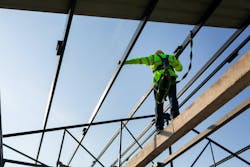29CFR 1926 Subpart M provides the requirements for fall protection. Subpart 1926.502 is the meat of Subpart M. It runs for several pages and covers 11 topics. Now we’ll give three of them a closer look:
(a) General
(b) Guardrail systems
(c) Safety net systems
General
Employers are responsible for providing and installing fall protection for each employee who needs it [1926.502(a)(2)]. Employers must also comply with all the pertinent requirements of Subpart M before that employee can begin the work that requires the fall protection. This means that if something isn’t right, the employee does not proceed. Subpart M has many requirements, but they are organized in a rational way.
Guardrail systems
OSHA has 15 distinct requirements for these. Some highlights are:
- There’s a height requirement for the top edge of the top rails. Generally, it’s 42 in. above the work surface [1926.502(b)(1)].
- Intermediate vertical members (e.g., midrails, screens, mesh, etc.) must run between the top rail and the work surface [1926.502(b)(2)].
- There are two 200-lb tests and one 150-lb test each of these installed systems must meet [1926.502(b)(3), (4), (5)].
- There are three requirements for using guardrails at or around holes [1926.502(b)(11), (12), (13)].
- Guardrail systems used on ramps and runways must be erected along each unprotected side or edge [1926.502(b)(14)].
Safety net systems
OSHA has nine distinct requirements for these. Some highlights:
- Safety nets must be installed as close as practicable to the working surface to reduce the fall distance as much as is practicable [1926.502(c)(1). In no case can they be installed more than 30 ft below the working surface.
- There must be sufficient clearance under the safety net that a person falling into it doesn’t contact the surface under the net [1926.502(c)(3)].
- Safety nets and their installations must be capable of passing the drop test specified in 1926.502(c)(4)(ii).
- Keep the nets clear of scrap, tools, etc. [1926.502(c)(6)].
- Connections between safety net panels must be as strong as integral net components are, and spaced not more than 6 in. apart [1926.502(c)(9)].
About the Author

Mark Lamendola
Mark is an expert in maintenance management, having racked up an impressive track record during his time working in the field. He also has extensive knowledge of, and practical expertise with, the National Electrical Code (NEC). Through his consulting business, he provides articles and training materials on electrical topics, specializing in making difficult subjects easy to understand and focusing on the practical aspects of electrical work.
Prior to starting his own business, Mark served as the Technical Editor on EC&M for six years, worked three years in nuclear maintenance, six years as a contract project engineer/project manager, three years as a systems engineer, and three years in plant maintenance management.
Mark earned an AAS degree from Rock Valley College, a BSEET from Columbia Pacific University, and an MBA from Lake Erie College. He’s also completed several related certifications over the years and even was formerly licensed as a Master Electrician. He is a Senior Member of the IEEE and past Chairman of the Kansas City Chapters of both the IEEE and the IEEE Computer Society. Mark also served as the program director for, a board member of, and webmaster of, the Midwest Chapter of the 7x24 Exchange. He has also held memberships with the following organizations: NETA, NFPA, International Association of Webmasters, and Institute of Certified Professional Managers.
